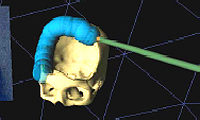Pre-surgical Cranial Implant Design using the PARIS™ Prototype
March 22nd, 2004
Categories: Applications, Virtual Medicine

Authors
Scharver, C., Evenhouse, R., Johnson, A., Leigh, J.About
Repairing severe human skull injuries requires customized cranial implants, and current visualization research aims to develop a new approach to create these implants.
Following pre-surgical design techniques pioneered at the University of Illinois at Chicago (UIC) in 1996, researchers have developed an immersive cranial implant application incorporating haptic force feedback and augmented reality. The application runs on the Personal Augmented Reality Immersive System (PARIS™), allowing the modeler to see clearly both his hands and the virtual workspace. The strengths of multiple software libraries are maximized to simplify development. This research lays the foundation to eventually replace the traditional modeling and evaluation processes.
Resources
Citation
Scharver, C., Evenhouse, R., Johnson, A., Leigh, J., Pre-surgical Cranial Implant Design using the PARIS™ Prototype, Proceedings of the IEEE Conference on Virtual Reality, Chicago, IL, March 22-24, 2004, March 22nd, 2004.